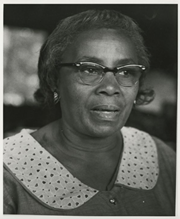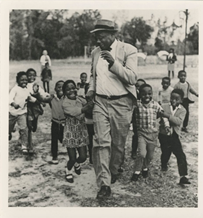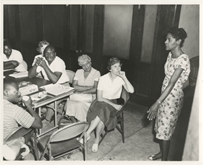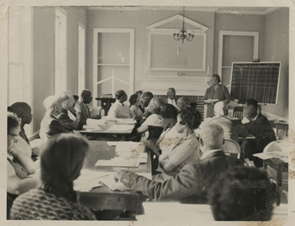» Part 3: Lowcountry Resistance by Mateo Mérida

White supremacy has not only been pervasive in the history of Charleston, but it is present in every structure that supports society in the Lowcountry. While Black Charlestonians have resisted this physical and institutional violence through rebellion and the simple continuation of daily life, they also resisted by creating their own institutions in response to white supremacy. One example, the Johns Island Citizenship School, is one of the most successful of these responses, as it directly confronted Black oppression with empowerment through education.
To understand the impact of the Citizenship School, an understanding of Lowcountry apartheid in the dawn of the Civil Rights Movement is imperative. Jim Crow policies proclaimed to be ‘separate but equal,’ yet majority Black regions such as Johns Island, were lacking in resources for a quality education that would uplift Black Johns Islanders. No person knew this better than Septima Poinsette Clark. Born and raised in Charleston, Clark graduated from the Avery Institute in 1916, and spent her early career teaching on John’s Island. She describes:
My school, there were one hundred and thirty two black children of school age down there and I had to—well there were two of us, I had from fourth through the seventh and the other teacher had from the first up to the fourth grade. And of course, there were not too many of the larger children coming until the harvest was over in November. And from the last of November to the last part of February we had the big children.1
Clark’s statement is revealing as a description of Jim Crow apartheid. First, teachers were absolutely overwhelmed by sprawling class sizes. Between two teachers, Clark was responsible for sixty-eight students at a given time. In comparison the student to teacher ratio is 13:1 in Charleston County School District (CCSD) today.2 Beyond incomprehensible class sizes, she could not reach all of her students because they withdrew from classes to work for several months. In this way, obviously Clark’s school was completely underserviced, and the conditions of life for Black students on Johns Island directly inhibited the ability to attain a meaningful education, since studying meant sacrificing pay to feed their siblings and parents.
Despite its outward appearance, Jim Crow education was not a failure: it properly functioned as a mechanism to restrict the abilities of Black Southerners. Jim Crow education placed every obstacle possible in the way of even the most masterful of teachers and gifted of students, which had huge implications politically. In Southern states like South Carolina, literacy test laws dictated that if a voter was not literate according to the examination, then they were prohibited from voting. In other words, if Black people could not read, then they could not vote, which reinforced their oppression, thus perpetuating the feedback loop for generations, as the tools to stop it were systematically kept from their reach.
Clark rejected this system of oppression. After being fired from CCSD for her involvement in the National Association for the Advancement of Colored People, she taught in the Highlander Folk Center in Tennessee. The Folk Center was an integrated education establishment that taught Black and white people in the Appalachian South to read and write. While it targeted Appalachia, it also saw engagement from Black Johns Islanders, such as Esau Jenkins, who had known Clark from her time on Johns Island. As the founder of the Progressive Club on Johns Island (which sought to provide solutions to an abundance of issues pertaining to Black Johns Islanders, such as transportation and legal defense), Jenkins had been active in the Lowcountry since the 1940s. Jenkins partook in workshops at the Highlander School and knew Septima Clark from her time on Johns Island. Together, they developed an idea to extend a model similar to the Highlander School in Charleston.3 They called it the Citizenship School.

The mission of the Citizenship School was simple: to teach the poor and neglected Black community of Johns Island to learn how to read and how to write. To do this, even though Clark was an active educator, they firmly believed that having members involved in the school who were familiar with the people of Johns Island was key for the school to work. They reached out to Bernice Robinson to be the primary teacher for the school. She describes “I was pegged to be the teacher, since I had been to Highlander in 1955,56, and knew the Highlander’s philosophy of ‘helping people to help themselves.’”4 In addition to being a Highlander participant, she was an ideal candidate as a prominent entrepreneur on Johns Island, making her a face that the community could trust and relate to. Thanks to the efforts of Clark, Jenkins, and Robinson, the Citizenship School operated from the site of the Progressive Club in 1957.5

Learning to read was an empowering experience for the Black community of Johns Island in several ways. For example, when handed a contract, Johns Islanders were better able to know what they were agreeing to, instead of signing at the word of the landlord, the loan debtor, or the lawyer. Furthermore, it allowed Johns Islanders to be more knowledgeable about the happenings within and well beyond their community.
While all of these were significant, the largest impact was political. Where the literacy test had served as a near insurmountable obstacle for millions of prospective Black voters, the Citizenship School gave them the tools to tear the obstacle down themselves. For the first in their lives, Citizenship Schools students were able to cast their vote, echoing across the entire Lowcountry. Not only had the number of voting Black Johns Islanders tripled in three years, but as many as 700 Gullah Geechee people were registered to vote, with nearly full participation in elections.6 The Citizenship School was a monumental success in the metrics of the increase in literacy rates and the fight to eradicate voter suppression. It was so successful that more Citizenship Schools were created across the South, first expanding into North Charleston and Wadmalaw Island. The Citizenship School reached as many as 28,000 students across the region from 1957 until 1970 and became a platform where many life-long educators got their start. Because the Citizenship School was so abundantly successful, Septima Clark is seen as a staple figure of the Civil Rights Movement.7
The Citizenship School stands in the history of the Lowcountry as an example of how the Lowcountry Black community built their own tools to destroy the weapons that oppressed them. The mechanisms to improve the lives of Black Sea Islanders always existed but were guarded by mechanisms crafted to withhold them. While other valid forms of resistance are manifested in revolution and survival, the Citizenship School was a force to change from within, welding a key to unlock the gate to political engagement, when they had only been given scrap metal. White supremacy methodically removed all support from Black people to participate in society, and the members of the Black community resisted by creating the means to defeat it.

Sources
- Clark, Septima P. “Oral History with Septima P. Clark.” South Carolina Historical Society: Charleston, SC. 1980. Pp. 3.
- “Charleston County School District.” U.S. News & World Report. n.d. Accessed Feb. 14, 2022. https://www.usnews.com/education/k12/south-carolina/districts/charleston-01-106145.
- “South Carolina| The Progressive Club of Johns Island.” National Park Service. Last Updated Sep. 23, 2021. Accessed Feb. 14, 2023. https://www.nps.gov/places/south-carolina-the-progressive-club-of-johns-island.htm
- “Bernice Robinson’s Involvement with Highlander School.” Bernice Robinson Papers, 1920-1989. Avery Research Center at the College of Charleston: Charleston, SC. n.d. Accessed Feb. 2, 2023. https://lcdl.library.cofc.edu/lcdl/catalog/lcdl:99193
- “Bernice Robinson.” Adult Learning Unleashed. Accessed Feb. 14, 2022. http://www.alu-c.com/bernice-robinson; Laurens, John & Leigh Scott. “National Register of Historic Places Registration Form.” Historic Preservation Consultants: Charleston, SC. Apr. 2, 2007. Accessed Feb. 14, 2023. http://www.nationalregister.sc.gov/charleston/S10817710183/S10817710183.pdf
- Jordan, Amanda Shrader. “Faith in Action: The First Citizenship School on Johns Island, South Carolina,” thesis. August 2008. East Tennessee State University: Johnson City, TN. Accessed Feb. 14, 2023. pp. 76. https://dc.etsu.edu/cgi/viewcontent.cgi?article=3316&context=etd
- Mellen Charron, Katherine. “Remembering Individuals, Remembering Communities: Septima P. Clark and Public History in Charleston.” Lowcountry Digital History Initiative: Charleston, SC. Feb. 2017. Accessed Feb. 14, 2023. https://ldhi.library.cofc.edu/exhibits/show/septima_clark
Images
- “Septima P. Clark.” Septima P. Clark Papers, ca. 1910-ca. 1990. Avery Research Center at the College of Charleston: Charleston, SC. Digitized Feb. 2016. Accessed Feb. 14, 2023. https://lcdl.library.cofc.edu/lcdl/catalog/lcdl:93131.
- “Esau Jenkins Gathering With Kids.” Esau Jenkins Papers, 1963-2003. Avery Research Center at the College of Charleston: Charleston, SC. Digitized Jul. 2016. Accessed Feb. 14, 2023. https://lcdl.library.cofc.edu/lcdl/catalog/lcdl:100263.
- “Photograph of Bernice Robinson Teaching.” Bernice Robinson Papers, 1920-1989. Avery Research Center at the College of Charleston: Charleston, SC. Digitized Apr. 2016. Accessed Feb. 14, 2023. https://lcdl.library.cofc.edu/lcdl/catalog/lcdl:100080.
- “Septima P. Clark Teaching Class of Adults, Liberty County, Georgia.” Septima P. Clark Papers, ca. 1910-ca. 1990. Avery Research Center at the College of Charleston: Charleston, SC. Digitized Feb. 2016. Accessed Feb. 14, 2023. https://lcdl.library.cofc.edu/lcdl/catalog/lcdl:93161.
